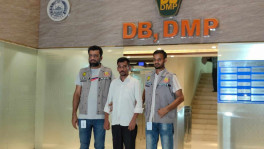Will the metrorail solve Dhaka’s traffic jams?
Getting rid of all these problems will not be achieved just by a single metro train, it must be solved by going deeper. The idea that the traffic congestion problem will have a permanent solution as soon as the metrorail is inaugurated is, therefore, just a myth

According to the World Bank, respectively 32 and 16 lakh working hours are being lost every day in the capital Dhaka and the port city of Chittagong due to traffic congestion. The yearly financial loss for one lakh working hours due to traffic congestion is estimated to be Tk1,000 crore.
In other words, at least Tk49,000 crore are being lost in traffic jams in Dhaka and Chittagong every year. Traffic congestion in both cities is costing $5.5 billion a year, 8.5% of the annual budget.
At present, the average vehicle speed in Dhaka is less than 7 kilometers per hour. The experience of walking faster in front of a car during heavy traffic is very familiar to city dwellers.
According to a study by BRAC University's Institute of Governance and Development, the average vehicle speed on Dhaka roads in 2004 was 21.2 kilometers per hour. This has now dropped to just 6.8 kilometers per hour.
If the number of vehicles continues to increase at the same rate and no steps are taken to reduce it, then according to the World Bank, the speed of vehicles in this city will be four kilometers per hour in 2025, which is less than the walking speed of a human being.
As the government is implementing the metrorail project, the question naturally arises, will it completely solve the traffic congestion problem of Dhaka? Including the two phases of MRT-1, there are six MRT lines, out of which one is being implemented at this time.
During the inauguration of Package-5 of MRT-6, Obaidul Quader said, "The entire work of metrorail will be completed by December 2020. And from Uttara to Agargaon will end in December 2019."
Of the 88 planned metro stations, 21 are being built now. No one knows exactly when all the 88 metro stations will be operating together, even though the project was approved by ECNEC in 2012.
The efficiency of the government of Bangladesh in implementing big projects has not been anything to write home about. Many medium and large projects are getting extended by several stages, which has terrible financial consequences.
But these delays also prevent these massive projects from being effective. In technical terms, dimensioning input may not match the future capacity demand, which is seen in almost every road and river bridge project of Bangladesh.
According to the Strategic Transport Plan (STP) to reduce traffic congestion in the capital, in 2016-17, there were an average of three crore trips per day in Dhaka and its surrounding areas (trip refers to personal travel).
To cope with the extra passenger pressure, four crore trips (or public transport) will be made in 2025 and five crores in 2035. Outside of this, there will be the growth of trips for transportation of goods.
As a result, the traffic commutation reference base of 2012-16 surveys for the capacity of the planned MRT routes may appear partially incorrect after 2025.
Another problem is that not all the routes are commencing at the same time - only one, instead of six, routes will be inaugurated in FY 2023-24.
So, in the absence of other routes, MRT-6 in Uttara-Mirpur-Motijheel may interfere and change Dhaka's natural business and housing growth center patterns. This may have consequences upon the capacity forecast and the dimensioning inputs to the other MRT routes as they are coming into operation much later in the current decade.

MRT-6 can transport 60,000 passengers per hour. But the traffic demand at the airport point during the peak hour of the day is higher. What percentage of this traffic will be attracted to and transported through MRT-6?
It depends on a few factors: MRT fares against marginal, lower and middle-income people's daily earnings, active and passive barriers on the personal cars on the same routes, commercial local bus route cancellation or equal bus fare rate adjustment in comparison with that of MRT.
And the culmination of all of these policies will determine the percentage of actual traffic jam reduction on the same route. Such integrated policies will also derive the future capacity growth factors of the MRT itself.
It will not be possible to ensure the most optimised use of Metro Rail if the fares are not determined on the basis of the income of working people, export-oriented and garment industry labourers, floating, lower, and middle-class peoples earnings.
Integrated planning should be done on how to restrict the use of private vehicles on metro-spreading routes. If commercial bus routes get forbidden on the same metro routes, the transport laborers must be offered alternative employment and job safety.
In the past, due to lack of such a ban, Dhaka's promising circular waterway could not take off. Female passenger privacy and security too, must be addressed on priority during both off peak and peak hours to make the MRT successful.
To get the benefit against traffic congestion from any public transport medium, a country has to plan, classify and divert the entry-exit traffic of the city from the main traffic of the city. Although we see the connection of Dhaka Airport with the two planned routes of Metrorail, we do not see the interconnection of the other 10 major entry-exit points of Dhaka.
As there are no alternative roads, passenger-freight routes, inter-district buses and trucks still will ply through Dhaka. As a result, the destination of future traffic congestion at these entrances remains completely uncertain and unknown.
In other words, the design of roads and public transport has not been given much importance through classifying the city's own traffic, airport, riverport, and Dhaka bypass traffic.
However, there is talk of the circular train in Dhaka. We do not yet know the depth of its planning and level of interconnectivity. It is true that Dhaka's entrances can be interconnected with Metrorail in the future by revising the plan, but where will the increased cost of billions of dollars come from?
Dhaka provides 36% of the total GDP of the country. If there was no traffic jam, it could have increased further. Due to traffic congestion, labour hours and productivity are declining along with the investors' interest.
Many economic and urbanisation opportunities are not available in the major cities of the country due to the same reasons.
Traffic congestion is also a major obstacle in gaining credible recognition as a sustainable middle-income country. In contrast to the rapid population growth, the slow implementation of traffic congestion management plans is also exacerbating the problem.
Besides the absence of a proper mass transportation medium, inefficient administration of Dhaka, centralised government and economic activities are largely responsible for the traffic jam.
There is absolutely no action plan for population reduction. In the ever-growing centralised administration, all small and big city planning, including DAP and DAP's "floor area ratio-based plans", are going to be certain failures.
Getting rid of all these problems will not be achieved just by a single metro train, it must be solved by going deeper. The idea that the traffic congestion problem will have a permanent solution as soon as the metrorail is inaugurated is, therefore, just a myth.
After 50 years of independence, we are still busy with Dhaka, no one is concerned about other cities like Chittagong, Sylhet, Rajshahi, Khulna, or Barisal city mass transportations.
To put it bluntly, if the political and administrative powers are not decentralised from the Prime Minister's Office, Secretariat, and the parliament to the lowest administrative units of city corporations, municipal corporations, and local governments and all public and private services do not go to the city corporation and upazila level, there will be no permanent solution to the Dhaka traffic jam.
The main task is to introduce real digital administration by empowering the local government in a sustainable model, like in developed countries. Wherever a person is born, he must be provided with education, health, police services and, above all, employment at the same place. Otherwise, some visible development after huge expenditure will be showcased, but the permanent solution of people's daily problems will not be achieved.
Faiz Ahmed Taiyeb is a Bangladeshi columnist and writer living in the Netherlands. He is the author of the books "Fourth industrial revolution and Bangladesh" and "50 years of Bangladesh economy".
Disclaimer: The views and opinions expressed in this article are those of the authors and do not necessarily reflect the opinions and views of The Business Standard.


 Keep updated, follow The Business Standard's Google news channel
Keep updated, follow The Business Standard's Google news channel
















